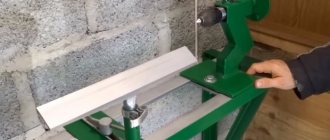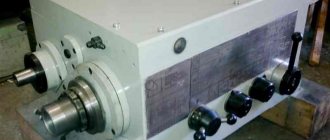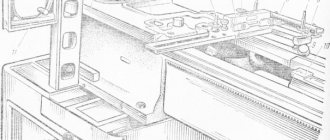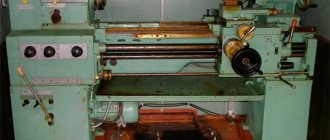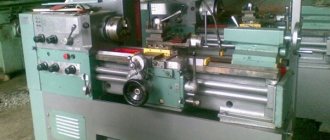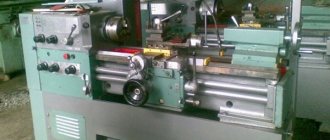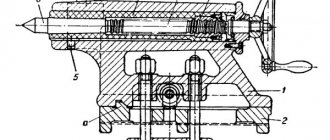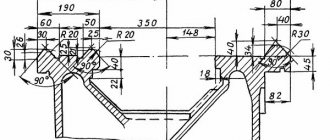In fact, the design of a lathe, regardless of its model and level of functionality, includes standard structural elements that determine the technical capabilities of such equipment. The design of any machine belonging to the category of turning group equipment consists of such basic elements as a headstock and tailstock, a support, a device apron, a gearbox for changing speeds, a feedbox, an equipment spindle and a drive motor.
Main parts of a metal lathe
Headstock
Tailstock
Caliper
Drive shafts
Gear shift lever
Limbo
History of the device
The history of a lathe with a caliper begins in 1712, when Andrey Konstantinovich Nartov, a mechanic from Russia, was the first to invent this mechanism. This significantly simplified the work with the device, because the turner no longer needed to hold the cutting tools with his own hands while processing the desired element.
This invention gave a powerful impetus, followed by the rapid development of metal and wood lathes.
Although the creation of the turning device and caliper is attributed to the Englishman Maudsley, the Russian mechanic was still more than seventy years ahead of him.
Latest abstracts of the section
- Trends in the development of the higher education system in Ukraine and abroad: main directions
- The influence of a health-saving approach in organizing educational work on the formation of valeological literacy in primary schoolchildren
- Characteristics of the competencies of bachelors – educational psychologists
- Corrective program to reduce anxiety in children of primary school age using clay therapy
- Formation of vocabulary in preschool children with general speech underdevelopment
- The role of visibility in teaching fine arts
- Active theoretical teaching methods
Copyright © 2010-2021 — www.refsru.com — abstracts, coursework and dissertations
The main components of a lathe
A unit such as a lathe, regardless of the model, is composed of similar structural elements, which mainly determine all the capabilities of the device.
Name of the main components of the screw-cutting lathe design:
- Bed - this element of the turning device serves as nothing more than one of the main supports for both headstocks and is a platform for moving the support and tailstock. All elements of the device are attached to it. The bed consists of two longitudinal walls, which are connected by transverse ribs for reliability and strength. The headstock of the lathe is fixed to the left side of the bed, the opposite side is where the tailstock is located.
- The headstock holds and rotates the workpiece along its own axis. In the inner part of this element of the lathe there is a spindle that rotates at different frequencies in rolling bearings and thereby transmits the rotation of the workpiece. The outer sides of both walls of the headstock are equipped with gearbox handles, which are switches for the number and speed of spindle revolutions. Instructions for the correct switching of these handbrake in order to set the required number of revolutions are located in the form of a metal plate on the outside of the walls of the headstock.
- Tailstock – supports the remainder of the element during processing. Additionally, it is used to install other working tools.
- Caliper - moves the cutting device in all directions to the axis of the turning device.
- Feed box - the design of almost all lathes is characterized by this element, which rotates the drive shaft and lead screw and changes the number of their revolutions around its axis. There are a large number of feedbox systems.
- Apron - used to change the movements of the drive shaft.
- On this device, it is strictly forbidden to simultaneously turn on the feed mechanism from the lead shaft together with the closure of the uterine nut on the lead screw. This action in almost all cases leads to breakdown of the elements of the turning device. To prevent this, there is a special mechanism in the lathe that completely blocks the entire device.
Main components and mechanism of action of the headstock
This element of the lathe is one of the main parts of any turning device. The accuracy of the location of the workpiece and the amplitude of its movements depend on it. In addition to the front headstock, all machines also have a back headstock - the cutting tool is attached to it. Both headstocks are fixed to the bed, which is the basis for any machine, and differ only in their location.
There are also grinding machines on which a third special grinding headstock is additionally attached, which is responsible for moving the grinding platform of this device.
There are the following main elements of a turning device that regulate the speed of turning the element being processed:
- Two bearings.
- Spindle.
- Pulley.
- A special gearbox, which is responsible for changing the rotation speed of the element being processed.
The main element of the headstock of a lathe is the spindle, the main task of which is to regulate the movement of the wrapping on the element being processed.
On the right side, facing the tailstock, there is a thread attached. Chucks are attached to it, which hold the part that is being processed. The spindle is mounted on two bearings, on which the accuracy of the work performed fully depends.
Also, a guitar of gears is fixed in the internal structure of the headstock. They transmit rotation from the gearbox output shaft to the feedbox shaft.
The headstock body is the main platform for all components. Its shape directly depends on the model of the turning device and can be very diverse. The lower surface of the body is smooth; all the guides are fixed into the tongue, which is located in the middle.
A gearbox is installed on the outside of the headstock of the lathe, which operates using gears.
Why is it needed and how does it work?
A lathe is designed for the manufacture of wooden products that have a cylindrical or similar shape. This is an indispensable thing when renovating a country house with a wooden staircase, a carved porch, but not only.
If you have some experience, a turning tool will allow you not only to save on purchased decorative elements, but also to earn money, because handmade wooden products are highly valued.
Whether such a machine is needed in a home workshop is up to the master to decide.
Of course, if you need several handles for chisels, it is easier to buy them, but if you want to make an all-wood staircase, then a set of balusters will cost a very large sum. It is much cheaper to make them yourself. By the way, you don’t even have to spend money on buying equipment - a simple machine can be made in your own workshop using scrap materials.
The operating principle of a wood lathe is not particularly complicated. The cylindrical workpiece is fixed along the axis of rotation. Torque is transmitted to it. By bringing various cutters or grinding tools to the workpiece, it is given the desired shape.
Main parts of lathe:
- a frame on which all components are fixed;
- electric drive;
- headstock;
- tailstock;
- handyman
For ease of operation, schemes for changing the rotation speed are used. In professional equipment, this is a real gearbox, a system of gears that allows you to regulate speed within a very wide range. This is difficult; it is enough to equip a homemade wood lathe with a belt drive with several pulleys of different diameters.
Spindle
The name of this element comes from German and is translated as “spindle”. This part is a shaft that is equipped with a mechanism for fastening the workpiece that is being processed. Usually the shaft is made with a hole in which the rods are processed. The spindle neck is conical or cylindrical.
Basic standards for spindle operation:
- Wrapping accuracy - it is adjusted based on standards, and has a direct dependence on the purpose of the device itself, its accuracy.
- The rigidity of the spindle assembly itself - this requirement is also met based on generally accepted standards.
- Vibration resistance is in no way a determinant of the quality of the workpiece.
- Spindle speed - the higher the speed of this unit, the higher the quality of the finished product.
- Load-bearing capacity - this parameter almost entirely depends on the quality of the spindle supports and the fluid for lubricating the device.
- Durability - this item depends only on the quality of the bearings.
- Heat allowed for bearings.
One of the main conditions for the manufactured part to be processed as accurately and accurately as possible is the correct torsion of the spindle. It should rotate evenly and easily.
DIY lathe headstock
The headstock for a lathe can be made independently without any problems.
For this purpose you will need:
- Wooden plank.
- Plywood, ten millimeters thick.
- A thin sheet of metal that is cut with special scissors.
It is much easier to make a headstock with your own hands if the basis of this device is an ordinary unnecessary drill. After this, it will only be necessary to make a stand, which will subsequently be the mounting platform for the drill, which has a strict horizontal axis.
The middle of the front and middle of the tailstock must be securely fastened, this is extremely necessary. For the tailstock, it is necessary to establish in advance the limits of the possibilities of wrapping along the axis and rigidly securing it in place.
The power of the electric motor should be selected independently, based on the purpose of the turning device. Although the engine power does not need to be less than 250 W. Otherwise, it will not be possible to turn out any necessary parts.
Nuances of choice
It is worth noting that spindles for CNC milling machines are more common than products for “simple” machines. There is nothing surprising here: such devices themselves have almost been supplanted. But you still need to immediately clarify whether the device is intended for working on metal or wood. Both household units in industry and industrial houses should not be used. Both of these only mean a waste of money. In any case, power comes first in selection.
Saving on it is strictly contraindicated. The greater the force applied, the longer the device will work (within certain limits, of course). Recommended values:
- for drilling and engraving work, an indicator of less than 600 W is enough;
- standard work with wood and metal sheets requires 0.8-1.4 kW;
- Daily CNC factory work requires a minimum of 1.6 kW.
Plywood and other panel wood materials are processed at powers of up to 3 kW, and solid wood, aluminum, bronze - up to 6 kW.
However, you should also understand that the milling itself can follow different scenarios. With the force method, the rate of rotation of the cutter far exceeds the intensity of the shaft movement. With high-speed, the cutting part itself does not move quickly, but is fed actively. Such approaches are used, respectively, with priorities for efficiency of work and quality of results. Of course, the spindle is selected of the appropriate class.
Setting up the lathe before starting work
Setting up a lathe means, first of all, preparing a kinematic diagram for work, which is determined by the technological map of the device.
First of all, all controls are brought to a static position.
Next comes the adjustment of the kinematic chain of the main movement. The required rotation speed of the spindle assembly is immediately set. This value determines the cutting speed of the required element.
Video: headstock of a wood lathe.
Production of SHU in Russia
Some of the spindle components required to complete machine tools are produced by domestic manufacturers at their own machine-tool manufacturing facilities, relying on the developments and experience of Soviet industry. There are practically no problems with the manufacture of conventional drive spindle units for a milling machine or turning units that are not oriented towards high-precision processing. However, modern high-tech electrospindles are produced in Russia only in parts and based on imported components. These restrictions are associated not only with the lack of advanced technologies in this area, but also with a shortage of qualified personnel who must solve engineering, technical and production problems.
